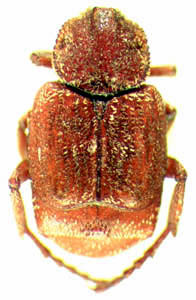| |
|
| Classification |
........Valgus
Scriba, 1790
........Valgus Scriba, 1790: 66 (valid name)
........Acanthurus Kirby, 1827: 155 (junior synonym)
........Homovalgus Kolbe, 1897: 214-215 (junior synonym) |
|
 |
|
Valgus
canaliculatus male
Image by K. A. Swoboda |
|
| . |
|
Map
showing the distribution of Valgus species in the New
World |
|
| |
| Cetoniinae Tribes
|
| |
| |
| Cetoniinae
Taxa Map |
| Key
to species of Valgini
|
| |
| |
| |
| |
| |
| |
| |
| |
| |
| |
| |
| |
| |
| |
| |
| |
| |
| |
| |
| |
| |
| |
| |
| |
| |
| |
| |
| |
| |
Distribution: Nearctic,
Palaearctic, and Indomalaysian realms. Nearctic species are found from
southern Mexico to the United States.
|
| |
| |
Revision or
Synopsis:
ARROW,
G.J. 1944. The beetles of the lamellicorn subfamily Valginae,
with a synopsis of the genera and descriptions of some new species.
Trans. Roy. Ent. Soc. London 94:225-246.
CASEY, T.L. 1909. Studies in the Caraboidea and Lamellicornia.
Canadian Ent. 41:253-284.
CAZIER, M.A. 1937. A new species of Valgus
and a new generic record for Mexico. Pan-Pac. Entomol. 13(4):190-192.
JAMESON, M.L. and K.A. SWOBODA. 2005. Synopsis of scarab beetle tribe Valgini (Coleoptera: Scarabaeidae: Cetoniinae) in the New World. Ann. Entomol. Soc. Am. 98(5): 658-672.
KRIKKEN, J. 1978. Valgine beetles: A preliminary review of
the genera, with descriptions of two novelties. Zoologische Mededelingen
53(15):154-164.
|
| |
| |
| |
| |
| |
| |
| |
| |
| |
| |
| |
| |
| |
| |
| |
| |
| |
| |
Composition:
The genus Valgus contains 20 species worldwide. The five New
World species are Valgus californicus Horn, 1870, Valgus
canaliculatus (Olivier, 1789), Valgus hemipterus L., 1758, and
Valgus seticollis (Palisot de Beauvois, 1807) .
|
| |
| |
| |
| |
Biological
Data: Valgus species have a one-year life cycle. Mating
occurs within termite galleries in stumps or fallen trees. Females have
a pygidial spine that they use to create sites for oviposition. Larvae,
pupae, and adults are found in decaying wood associated with termite
colonies.
|
| |
| |
| |
| |
Temporal
Distribution: Adults have been collected on flowers in the
spring and summer.
|
| |
| |
Larvae:
Valgus larvae feed on the walls of termite burrows in logs
or standing dead trees. The larvae of three New World species have been
described: Valgus californicus Horn (Ritcher 1966), Valgus
canaliculatus (Olivier) (Ritcher 1945, 1966), and Valgus hemipterus
L. (Medvedev 1969).
|
| |
| |
| |
| |
Species
profiles: (click
on species names)
|
| |
| |
| |
| |
| |
| |
Key
to species
|
| |
References:
BANKS, N. and T.E. SNYDER. 1920. A revision of the
nearctic termites. Bull. U.S. Nat. Mus. 108:1-211.
CAZIER, M.A. 1937. A new species of Valgus
and a new generic record for Mexico. Pan-Pac. Entomol. 13(4):190-192.
KRAJCIK, M. 1999. Cetoniidae of the world: Catalogue-Part
II. Privately published by author, Czech Republic. 72pp.
MEDVEDEV, S.I. 1969. On the larvae of Valgus hemipterus
L. (Coleoptera: Scarabaeidae). Entomol. Rev. 48:100-101.
RATCLIFFE, B.C. 1991. The scarab beetles of Nebraska.
Bulletin Univ. Nebr. St. Mus. 12:1-333.
RITCHER, P.O. 1945. North American Cetoniinae with
descriptions of their larvae and keys to genera and species (Coleoptera:
Scarabaeidae). Ky. Agr. Expt. Sta. Bull. 476, 39pp.
RITCHER, P.O. 1958. Biology of Scarabaeidae. Annual
Rev. of Entomology 3:311-344.
RITCHER, P.O. 1966. White Grubs and Their Allies.
Oregon St. Univ. Press, Corvallis. 219 p.
|
| |
| |
| |
| |
| |
| |
| |
| |
| |
| |
| |
| |
| |
| |
| |
| |
| |
| |
| |
| |
| |
| |
| |
| |
| |
|
| |

